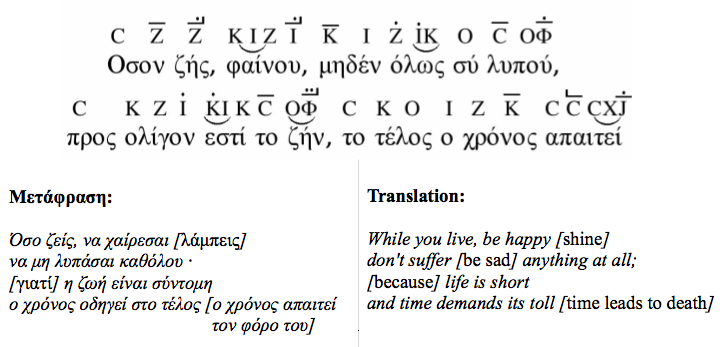-
-


Aratta (Sumerian), Uratri (Hurrian), Urartu/Ararat (Assyrian) and Armenia (Persian) is all different names of the same state, the state today known as Armenia. Here the people of fire, also known as Ar, Ur or Hur, three different names of the same people, lived, and live.
A common ancestor of Indo-European and Hurrian
Once upon a time, there was writing, but not music notation. Authors could record their words in books for posterity; although musicians sang and played instruments, their melodies vanished in the moment. In the middle of the 7th century, Isidore of Seville wrote a twenty-book encyclopedia in which he summarized the knowledge of the world. In it, he stated that melodies could not be written down, and, as one would expect from this declaration of impossibility, it included no music notation.
Strictly speaking, Saint Isidore was wrong. Melodies could be written down, because they had been written down by the ancient Greeks. In 1883, around the same time Edison was complicating the history of sound-writing with the invention of the phonograph, the Scottish archeologist Sir William Mitchell Ramsay complicated it with his own discovery of the “oldest complete musical composition ever found.” In Asia Minor (modern Turkey), in the first century AD, the Greek poet Seikilos had composed a song in memory of his wife Euterpe, which he chiseled in everlasting stone: The Seikilos Tablet.
The Hurrians (Ḫu-ur-ri) were a people of the Bronze Age Near East. They spoke a Hurro-Urartian language called Hurrian, and lived in Anatolia and Northern Mesopotamia.
The largest and most influential Hurrian nation was the multi-ethnic kingdom of Mitanni, the Mitanni being perhaps an Indo-European-speaking people who formed a ruling class over the Hurrians. The population of the Indo-European-speaking Hittite Empire in Anatolia included a large population of Hurrians, and there is significant Hurrian influence in Hittite mythology.
By the Early Iron Age, the Hurrians had been assimilated with other peoples, except perhaps in the kingdom of Urartu. According to a hypothesis by I.M. Diakonoff and S. Starostin, the Hurrian and Urartian languages are related to the Northeast Caucasian languages.
The Hurrian songs are a collection of music inscribed in cuneiform on clay tablets excavated from the ancient Amorite city of Ugarit which date to approximately 1400 BC. One of these tablets, which is nearly complete, contains the Hurrian cult hymn or A Zaluzi to the Gods, sometimes simply known as h.6, a hymn to Nikkal, wife of the moon god, making it the oldest surviving substantially complete work of notated music in the world. While the composers’ names of some of the fragmentary pieces are known, h.6 is an anonymous work.
The most ancient example of written song. A hymn to Nikkal The text is written upon a fragmented tablet and, therefore, is incomplete. The hymn has four stanzas, each with a refrain. Stanzas 1 and 4 are imitation, and stanzas 2 and 3 are identical musically. The singer is accompanied by a lyra. The lyra harmony is predominantly in thirds and sixths, a few fourths, and one fifth.
There are startling similarities between the Babylonian principles of music theory and those used by ancient Greeks. Moreover, the Babylonian principles antedate the Greek ones by more than a millenium.
The Babylonians seem to have used music exclusively in connection with religious observances and festivals. The names of lyra/kithara strings and musical pitches were related to their cult deities and to the planets in a cosmology similar to Greek philosophers’ “harmony of the spheres.”
The Seikilos epitaph is a Hellenistic Ionic song in Phrygian octave species and the oldest surviving example of a complete musical composition, including musical notation, from anywhere in the world. The song, the melody of which is recorded, alongside its lyrics, in the ancient Greek musical notation, was found engraved on a tombstone, near Aidin, Turkey (not far from Ephesus). The find has been dated variously from around 200 BC to around AD 100, but the first century AD is the most probable guess.
Also on the tombstone is an indication that states in Greek “Εἰκὼν ἡ λίθος εἰμί.Τίθησί με Σείκιλος ἔνθα μνήμης ἀθανάτου σῆμα πολυχρόνιον”, “I am a tombstone, an image. Seikilos placed me here as an everlasting sign of deathless remembrance”.
The music of ancient Greece was almost universally present in society, from marriages and funerals to religious ceremonies, theatre, folk music and the ballad-like reciting of epic poetry. It thus played an integral role in the lives of ancient Greeks.
There are significant fragments of actual Greek musical notation as well as many literary references to ancient Greek music, such that some things can be known—or reasonably surmised—about what the music sounded like, the general role of music in society, the economics of music, the importance of a professional caste of musicians, etc.
Even archaeological remains reveal an abundance of depictions on ceramics, for example, of music being performed. The word music comes from the Muses, the daughters of Zeus and patron goddesses of creative and intellectual endeavours.
The sounds of scales vary depending on the placement of tones. Modern Western scales use the placement of whole tones, such as C to D on a modern piano keyboard, and half tones, such as C to C-sharp, but not quarter-tones (“in the cracks” on a modern keyboard) at all.
This limit on tone types creates relatively few kinds of scales in modern Western music compared to that of the Greeks, who used the placement of whole-tones, half-tones, and even quarter-tones (or still smaller intervals) to develop a large repertoire of scales, each with a unique ethos.
The Greek concepts of scales (including the names) found its way into later Roman music and then the European Middle Ages to the extent that one can find references to, for example, a “Lydian church mode”, although name is simply a historical reference with no relationship to the original Greek sound or ethos.
The Mushki were an Iron Age people of Anatolia, known from Assyrian sources. They do not appear in Hittite records. Several authors have connected them with the Moschoi (Μόσχοι) of Greek sources.
Two different groups are called Muški in the Assyrian sources (Diakonoff 1984:115), one from the 12th to 9th centuries, located near the confluence of the Arsanias and the Euphrates (“Eastern Mushki”), and the other in the 8th to 7th centuries, located in Cappadocia and Cilicia (“Western Mushki”).
Assyrian sources identify the Western Mushki with the Phrygians, while Greek sources clearly distinguish between Phrygians and Moschoi.
Identification of the Eastern with the Western Mushki is uncertain, but it is of course possible to assume a migration of at least part of the Eastern Mushki to Cilicia in the course of the 10th to 8th centuries, and this possibility has been repeatedly suggested, variously identifying the Mushki as speakers of a Georgian, Armenian or Anatolian idiom.
The Encyclopedia of Indo-European Culture notes that “the Armenians according to Diakonoff, are then an amalgam of the Hurrian (and Urartians), Luvians and the Proto-Armenian Mushki (or Armeno-Phrygians) who carried their IE language eastwards across Anatolia.”
The Armenian hypothesis of the Proto-Indo-European Urheimat, based on the Glottalic theory suggests that the Proto-Indo-European language was spoken during the 4th millennium BC in the Armenian Highland. It is an Indo-Hittite model and does not include the Anatolian languages in its scenario.
The phonological peculiarities proposed in the Glottalic theory would be best preserved in the Armenian language and the Germanic languages, the former assuming the role of the dialect which remained in situ, implied to be particularly archaic in spite of its late attestation.
The Proto-Greek language would be practically equivalent to Mycenaean Greek and date to the 17th century BC, closely associating Greek migration to Greece with the Indo-Aryan migration to India at about the same time (viz., Indo-European expansion at the transition to the Late Bronze Age, including the possibility of Indo-European Kassites).
The Armenian hypothesis argues for the latest possible date of Proto-Indo-European (sans Anatolian), roughly a millennium later than the mainstream Kurgan hypothesis. In this, it figures as an opposite to the Anatolian hypothesis, in spite of the geographical proximity of the respective suggested Urheimaten, diverging from the timeframe suggested there by as much as three millennia.
Graeco-Aryan (or Graeco-Armeno-Aryan), invoked in particular in studies of comparative mythology, e.g. by West (1999) and Watkins (2001), is a hypothetical clade within the Indo-European family, ancestral to the Greek language, the Armenian language, and the Indo-Iranian languages.
Graeco-Aryan unity would have become divided into Proto-Greek and Proto-Indo-Iranian by the mid 3rd millennium BC. Conceivably, Proto-Armenian would have been located between Proto-Greek and Proto-Indo-Iranian, consistent with the fact that Armenian shares certain features only with Indo-Iranian (the satem change) but others only with Greek (s > h).
Graeco-Armeno-Aryan has comparatively wide support among Indo-Europeanists for the Indo-European Homeland to be located in the Armenian Highland. Early and strong evidence was given by Euler’s 1979 examination on shared features in Greek and Sanskrit nominal flection.
Used in tandem with the Graeco-Armeno-Aryan hypothesis, the Armenian language would also be included under the label Aryano-Greco-Armenic, splitting into proto-Greek/Phrygian and “Armeno-Aryan” (ancestor of Armenian and Indo-Iranian).
In the context of the Kurgan hypothesis, Greco-Aryan is also known as “Late PIE” or “Late Indo-European” (LIE), suggesting that Greco-Aryan forms a dialect group which corresponds to the latest stage of linguistic unity in the Indo-European homeland in the early part of the 3rd millennium BC. By 2500 BC, Proto-Greek and Proto-Indo-Iranian had separated, moving westward and eastward from the Pontic Steppe, respectively.
If Graeco-Aryan is a valid group, Grassmann’s law may have a common origin in Greek and Sanskrit. (Note, however, that Grassmann’s law in Greek postdates certain sound changes that happened only in Greek and not Sanskrit, which suggests that it cannot strictly be an inheritance from a common Graeco-Aryan stage. Rather, it is more likely an areal feature that spread across a then-contiguous Graeco-Aryan-speaking area after early Proto-Greek and Proto-Indo-Iranian had developed into separate dialects but before they ceased being in geographic contact.)
Armeno-Phrygian is a term for a minority supported claim of hypothetical people who are thought to have lived in the Armenian Highland as a group and then have separated to form the Phrygians and the Mushki of Cappadocia.
It is also used for the language they are assumed to have spoken. It can also be used for a language branch including these languages, a branch of the Indo-European family or a sub-branch of the proposed Graeco-Armeno-Aryan or Armeno-Aryan branch.
Classification is difficult because little is known of Phrygian and virtually nothing of Mushki, while Proto-Armenian forms a subgroup with Hurro-Urartian, Greek, and Indo-Iranian. These subgroups are all Indo-European, with the exception of Hurro-Urartian.
Note that the name Mushki is applied to different peoples by different sources and at different times. It can mean the Phrygians (in Assyrian sources) or Proto-Armenians as well as the Mushki of Cappadocia, or all three, in which case it is synonymous with Armeno-Phrygian.
Filed under: Uncategorized

